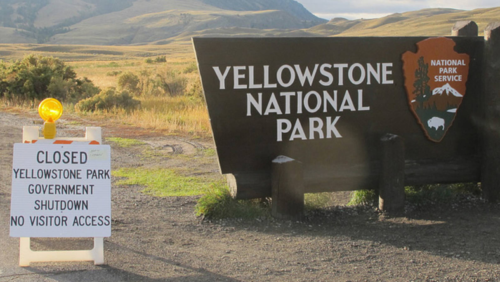To Close or Not to Close: National Parks in the Face of Government Shutdowns
January 24, 2019 by Sylvie Yudin

Government shutdowns can have drastic effects on National Parks. It is up the administration under which the shutdown is occurring to decide whether or not to permit National Parks to remain open, and this decision can have lasting consequences on the environmental sanctity of the Parks.
Shutdowns of the United States government have many predictable effects. However, the effects, and how to remedy them, of government shutdowns on National Parks are less clear. Since 1980, there have been fifteen government shutdowns, most of which lasted between one and three days.[1] However, a government shutdown under President Clinton lasted twenty-one days, and a government shutdown under President Obama lasted sixteen days.[2] On December 22, 2018 President Trump initiated a government shutdown. This ongoing shutdown is the longest in history and has posed a serious threat to National Parks.
The Clinton and Obama administrations closed National Parks during government shutdowns.[3] Conversely, the Trump administration has kept National Park locations open while simultaneously stopping the services provided by the National Park Service.[4] As a result, parks are experiencing deteriorating conditions as human waste and garbage are accumulating on park grounds.[5] The National Park Service released a Contingency Plan on January 7, 2019 detailing how it will act during the shutdown. It states that “The NPS will not issue permits, conduct interpretive or educational programs, collect trash, operate or provide restrooms, maintain roads or walkways (including plowing and ice melting), or provide visitor information.”[6] This is problematic, as the limited resources going towards maintaining the parks have led to potential degradation of natural resources and historic artifacts that are found in the parks.[7]
The environmental sanctity of these protected areas is clearly threatened. Many private citizens have taken action to help clean at-risk sites. Joshua Tree park for instance, was seeing between one hundred thousand and two hundred thousand visitors during the early days of the shutdown, with no working park service staff members.[8] A group of volunteers calling itself the “Toilet Paper Angels” brought hundreds of toilet paper rolls to clean the park and removed four thousand pounds of trash from the grounds in just one day.[9] Volunteer action alone, though, was not enough to solve the problems posed by the shutdown, and the park has since been forced to close.[10]
At the sixteen-day mark of the shutdown, Interior Secretary David Bernhardt implemented an unprecedented policy under which the National Park Service will use entrance fees to clean park sites.[11] Fees usually go towards bettering visitor experience and are not used to fund essential maintenance work.[12] This is a temporary solution until fees are depleted, but it allows for some parks, whose conditions are not too dire, to remain open. However, it will impair finances for future park services.[13] The National Parks Conservation Association warned that using entrance fees to fund services during the shutdown would further impoverish National Parks in the face of an already daunting eleven billion dollar maintenance backlog.[14] It also may interfere with the ability of the National Park Service to fulfill its responsibilities under the National Park Service Organic Act (16 U.S.C. Sections l 2 3, and 4), which states that the purpose of the NPS is to “conserve the scenery and the natural and historic objects and the wild life” and “to provide for [their] enjoyment . . . in such manner and by such means as will leave them unimpaired for the enjoyment of future generations.”[15] An additional problem with the new allocation of fees is that it is a potential violation of appropriations law. The Federal Lands Recreation Enhancement Act 16. U.S.C. 6807 Expenditures Section a3 holds that park fees collected under the Act are to be used for visitor services, not to fund basic operations and maintenance.[16] Therefore, the legitimacy of this solution is questionable.
Long term government shutdowns seem to be on the rise, as three of the longest shutdowns in American history occurred within the past twenty-five years.[17] Policy makers cannot rely on volunteer services alone and ought to develop more sustainable contingency plans on how to keep National Parks clean and safe during government closures.
[1] Doug Criss, We’re In Week 2. How Long did the Longest Government Shutdown Stretch? 21 days, CNN (Jan. 3, 2019) https://www.cnn.com/2019/01/03/politics/government-shutdown-length-trnd/index.html).
[2] Id.
[3] Darryl Fears & Juliet Eilperin, Three Dead in National Park System Accidents as Shutdown Wears On, Washington Post (Jan. 5, 2019) https://www.washingtonpost.com/energy-environment/2019/01/04/three-dead-national-parks-shutdown-wears/?utm_term=.fbfcf04b3506.
[4] Id.
[5] Trash and Feces Pile Up As Shutdown Leaves National Parks Vulnerable, CBS (Jan. 1, 2019) https://www.cbsnews.com/news/government-shutdown-national-parks-trash-human-feces-pile-up-furlough-risk/?fbclid=IwAR304725zULr7UESy4Z0YY2gsDEWpT-yrUArPr_BsoqPGsTjYihLsGGwLjk.
[6] National Park Service Contingency Plan January 2019 Pg. 3
[7] Trash and Feces Pile Up As Shutdown Leaves National Parks Vulnerable, CBS (Jan. 1, 2019) https://www.cbsnews.com/news/government-shutdown-national-parks-trash-human-feces-pile-up-furlough-risk/?fbclid=IwAR304725zULr7UESy4Z0YY2gsDEWpT-yrUArPr_BsoqPGsTjYihLsGGwLjk.
[8] Rebecca Ellis, National Park Service Plans to Expand Operations Amid Government Shutdown, NPR (Jan. 6, 2019) https://www.npr.org/2019/01/06/682686357/national-park-service-plans-to-expand-operations-amid-government-shutdown-degrad.
[9] Id.
[10] Tony Shin, Joshua Tree National Park Campgrounds Closed Due to Government Shutdown, NBC (Jan. 2, 2019) https://www.nbclosangeles.com/news/local/Joshua-Tree-National-Park-Campgrounds-Closed-Government-Shutdown-503820101.html.
[11] Rebecca Ellis, National Park Service Plans to Expand Operations Amid Government Shutdown, NPR (Jan. 6, 2019) https://www.npr.org/2019/01/06/682686357/national-park-service-plans-to-expand-operations-amid-government-shutdown-degrad, Caitlin Emma, Shutdown Workaround: National Park Service Taps Visitor Fees for Cleanup, Politico (Jan. 7, 2019) https://www.politico.com/story/2019/01/07/national-parks-government-shutdown-trash-1063328.
[12] Caitlin Emma, Shutdown Workaround: National Park Service Taps Visitor Fees for Cleanup, Politico (Jan. 7, 2019) https://www.politico.com/story/2019/01/07/national-parks-government-shutdown-trash-1063328.
[13] Rebecca Ellis, National Park Service Plans to Expand Operations Amid Government Shutdown, NPR (Jan. 6, 2019) https://www.npr.org/2019/01/06/682686357/national-park-service-plans-to-expand-operations-amid-government-shutdown-degrad.
[14]Sarah Gibbens, National Parks Face Years of Damage from Government Shutdown, National Geographic (Jan. 7, 2019) https://www.nationalgeographic.com/environment/2019/01/why-national-parks-trashed-during-government-shutdown/.
[15] National Park Service Organic Act (16 U.S.C. l 2 3, and 4).
[16] Rebecca Ellis, National Park Service Plans to Expand Operations Amid Government Shutdown, NPR (Jan. 6, 2019) https://www.npr.org/2019/01/06/682686357/national-park-service-plans-to-expand-operations-amid-government-shutdown-degrad.
[17] Doug Criss, We’re In Week 2. How Long did the Longest Government Shutdown Stretch? 21 days CNN (Jan. 3, 2019) https://www.cnn.com/2019/01/03/politics/government-shutdown-length-trnd/index.html).

